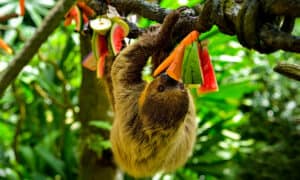You might think of sloths as cute but lazy animals that do nothing but lounge in trees all day. But there’s a lot more to these creatures than meets the eye! For example, sloths are excellent swimmers but struggle to walk. And sloths only poop once a week! Keep reading to learn 10 incredible facts about sloths that will make you see them in a whole new light.

10. Sloths can hold their breath for almost 40 minutes

Unau, Linnaeus’s two-toed sloth (Choloepus didactylus) in a tree.
©Saad315/Shutterstock.com
When you learn how long sloths can hold their breath, they start looking like adorable slow-moving oxygen tanks! But, all kidding aside, it’s true that these slow animals can hold their breath for a whopping 40 minutes at a time.
For the most part, a sloth would hold its breath for this long while underwater. But we can imagine other scenarios where this ability would come in handy, like when a sloth is trying to be very quiet and still to hide from predators.
How is a sloth able to hold its breath for long periods? It all leads back to their low metabolic rate and the fact that their bodies are very efficient at using oxygen. Additionally, sloth lungs are large in proportion to their body size. And their lungs have a high concentration of myoglobin, a protein that helps bind oxygen and store it in muscles and blood.
All these factors together mean that sloths can survive on very little oxygen for quite a long time if necessary.
9. Sloths poop once a week

The sloth can go for a week without eating or pooping.
©SergioDelgado / CC BY 2.0, Flickr – License
If you think sloths move their limbs slowly, you might be shocked to learn that things move at a sloth’s pace inside their bodies too. This is because the sloth has a prolonged metabolism and digestive and urinary systems. All those slow-moving systems mean that sloths don’t need to go to the bathroom as often as other animals. It also means that about 1/3 of a sloth’s body weight is from the waste matter they hold in their digestive tract.
Another advantage of their slow metabolism is that sloths don’t need to eat much. As a result, sloths can go without food for at least a week. When they finally crawl down the tree to urinate and defecate, sloths usually do their business in the same spot each time. This keeps their fur clean and free of parasites.
However, don’t be fooled by the appearance of clean-looking sloth fur. That fur is a hotbed of activity! Though it’s essential to keep the parasites at bay, a sloth’s fur is an ecosystem of its own full of living beings.
8. Up to 150 tiny creatures live in a sloth’s fur
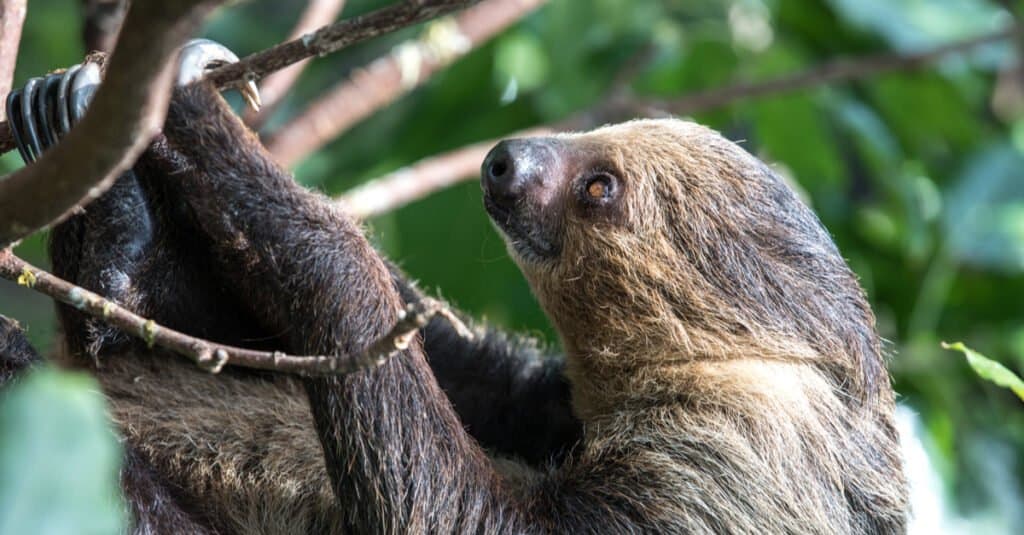
Lots of tiny organisms live in a sloth’s fur.
©Kertu/Shutterstock.com
At any given moment, a sloth houses up to 150 creatures in its fur. These creatures include mites, ticks, beetles, and lice. Some of the tiny fur dwellers are so small that they can only be seen with a microscope. Yet the sloth doesn’t mind all those critters nestling in their coat. The organisms living in a sloth’s fur help keep the sloth warm and protect it from predators.
One way that the tiny creatures in a sloth’s fur help protect it from harm is by providing camouflage. A sloth’s fur is typically green, which helps the animal blend in with its surroundings. This creature-created camouflage makes it more difficult for predators to spot the sloth and therefore makes it less likely to be attacked.
Another way that the organisms in a sloth’s fur help protect the animal is by deterring predators from attacking. Some of these organisms, such as mites and ticks, can be pretty irritating to predators if they come into contact with them. As a result, predators aren’t as likely to attack a sloth for fear of getting bitten or scratched by a hidden creepy-crawly.
Organisms that live in a sloth’s fur also help to protect the animal by providing it with a source of food. These organisms can be eaten by the sloth if it is ever stranded without a way to feed itself for long periods.
7. Sloths are great swimmers but can barely walk

A sloth’s long arms are great for hanging and swimming.
©Ontley, CC BY-SA 3.0, via Wikimedia Commons – License
A sloth’s body is made for hanging in trees and swimming in tropical waters. However, you won’t often see a sloth out taking a stroll. That’s because sloth legs aren’t built to hold up their body weight for long or with much strength.
A sloth’s limbs are long and thin, with excellent grip and maneuverability in the branches. Still, they’re just plain clumsy on the ground.
It’s interesting to note that sloths have a low percentage of muscle mass overall (25-30%) compared to most other mammals (40-45%). But one place their muscles really shine is in the water.
Sloths are strong and graceful swimmers. Their arms produce powerful strokes, and their webbed feet easily glide through the water. Sloths often swim in rivers and lakes and cross large stretches of open water. So while they may not be able to walk very well, sloths have impressive swim skills.
There are several reasons why sloths might go into the water. One reason a sloth might need to swim is to find food. Algae and other aquatic plants can be a good source of nutrients for sloths. Another reason is to escape from predators. Staying in the water (and camouflaged by floating algae) helps sloths avoid becoming dinner for Harpy eagles and other predators. Finally, sloths might also go into the water to cool off on hot days.
6. Sloths spend very little time on the ground

Sloths are arboreal.
©Damsea/Shutterstock.com
As arboreal animals, sloths live in trees. Additionally, sloths have a strong dislike of being on the ground. It is believed that this aversion is because the ground is much more dangerous for them than the safety of the trees. In addition, many predators would love to make a meal out of a slow-moving sloth. Being on the ground makes sloths an easy target. For all these reasons, sloths prefer to stay high up in the trees, where they feel safe and comfortable.
Sloths are so uncomfortable spending time on the ground that sometimes young sloths suffer the consequences. For example, if a young sloth crawls or falls out of the tree, its mother might not come down even if her offspring is hurt or in danger.
5. Sloths don’t like to be touched
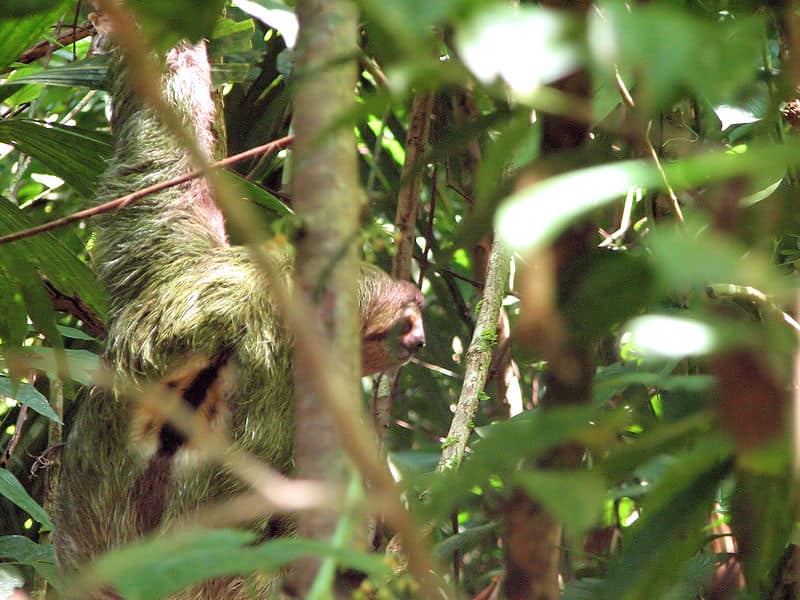
A sloth spends most of its time alone.
©D. Gordon E. Robertson, CC BY-SA 3.0, via Wikimedia Commons – License
Sloths are naturally shy and reclusive animals and don’t like to be touched or petted by humans. They are also sensitive to noise and commotion, so they can quickly become alarmed or upset. For these reasons, it’s best to leave sloths alone and admire them from a distance.
Though sloths don’t like to be handled, they aren’t usually dangerous to humans. This is because sloths are generally gentle and docile creatures.
However, even though they aren’t a threat, sloths have very sharp claws. Their huge claws are handy for climbing and defending themselves if attacked. But they could hurt a human accidentally. So if you decide to hold or get near a sloth, do so with caution.
4. Female sloths give birth to one baby per pregnancy — in a tree!
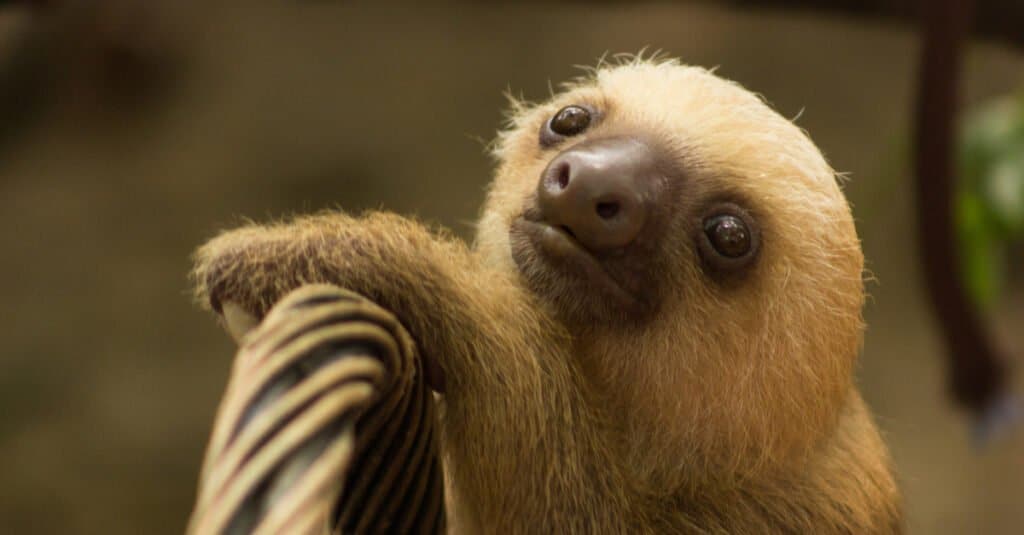
Baby sloths are often born in trees.
©Kristen Pareti/Shutterstock.com
Female sloths usually give birth to a single baby at a time, though twins have been reported. The gestation period lasts around six months.
One of the most fascinating things about sloths is that they sometimes give birth while hanging in trees. It is believed that this behavior helps protect the young from predators. When a baby sloth is born, it clings to its mother’s fur to keep it from falling out of a tree. Then, the mother takes her newborn cub to a safe place in the tree where it can nurse and grow.
Giving birth while hanging in trees is just one of the many interesting things about sloth parents and their babies. Sloth cubs are born looking ready for the world in more ways than one!
3. Baby sloths are born with open eyes and a full coat of fur
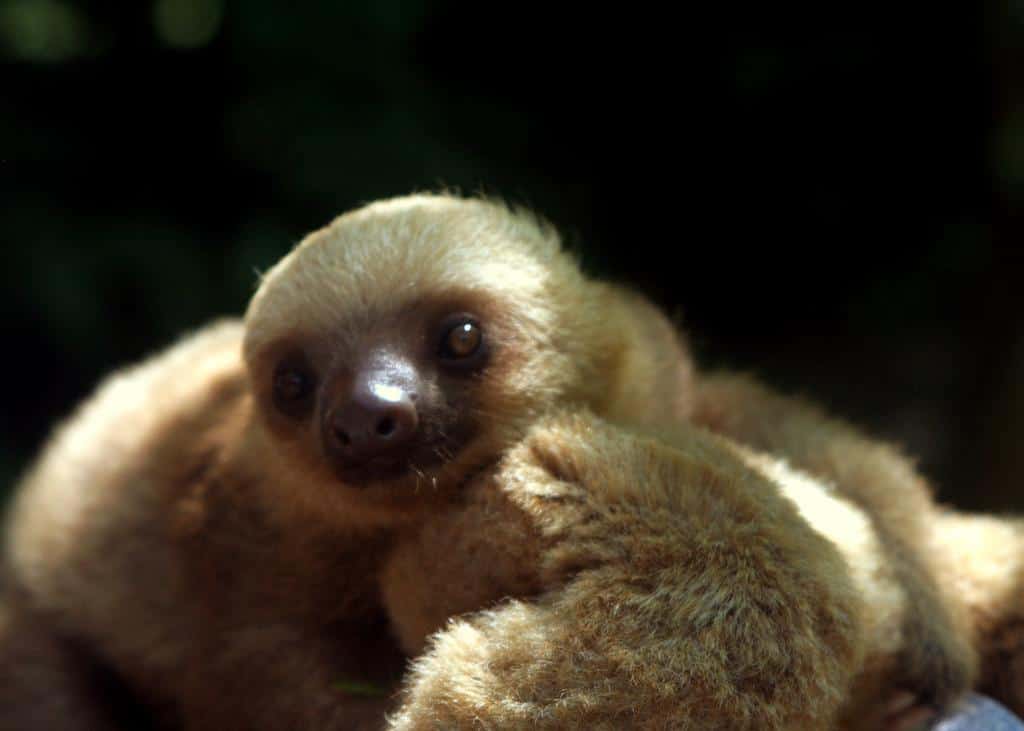
Newborn sloths have a full coat of hair.
©Dave Gingrich / CC BY-SA 2.0, Flickr – License
Sloths move slowly, but sloth babies are born ready to see and experience their surroundings. Their coats don’t need to grow in, as their bodies are already covered in fur. Their eyes are fully open and functional. And sloth cubs climb on their own within their first few days of life!
Baby sloths are about the size of a stick of butter at birth and stay with their mothers for the first few months. After that, they’re on their own.
After giving birth, sloth mothers clean the baby and help it climb onto her back. Babies nurse from their mother for about a month before eating solid foods. Then sloth cubs begin to eat leaves, insects, and small lizards. As they grow older, baby sloths eat more leaves and fewer insects. By the time they’re a year old, the young sloths eat mostly plant foods.
Though modern sloths eat mainly plants, new studies show that giant meat-eating sloths roamed the earth 10,000-20,000 years ago! Though their lifespan might not have been as long as sloths live today.
2. Sloths live up to 30 years in captivity

A sloth in captivity might live up to 30 years.
©iStock.com/Nachosuch
In the wild, sloths have an average lifespan of up to 10-20 years but can live up to 30 years with great care in captivity. Sloths in captivity tend to live longer because they are protected from predators and have easy access to food and medical care.
Most wild sloths live in the rainforests of Central and South America and have a few predators in their natural habitat. Large birds of prey, like Harpy eagles and hawks, will attack sloths. Jaguars and pumas will also hunt sloths. Snakes, such as boa constrictors, will sometimes eat sloths as well. Humans are also sometimes a threat to sloths when they are hunted for their fur.
1. Sloths sleep at least 15 hours a day
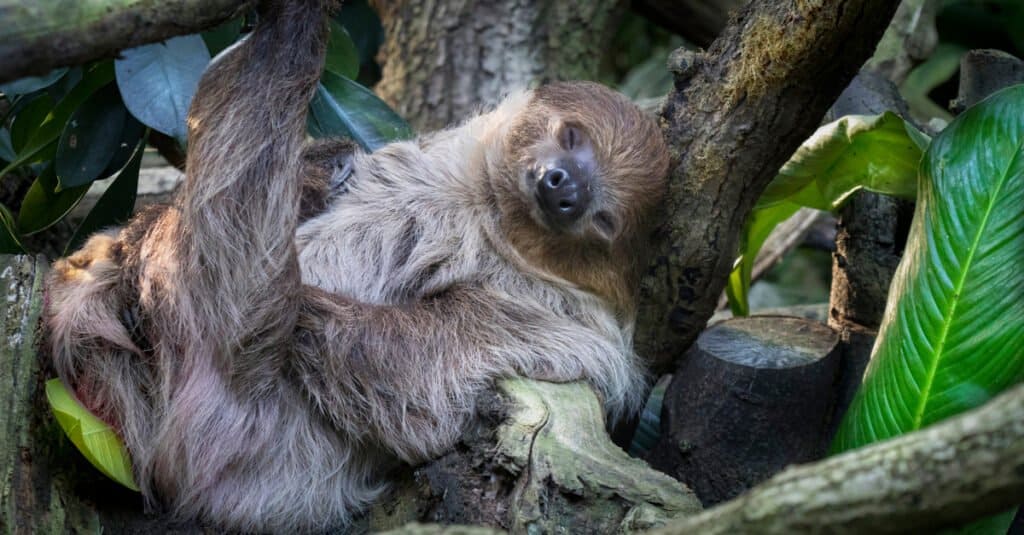
A sloth often sleeps in trees.
©milan noga/Shutterstock.com
Sleep is one of the sloth’s favorite pastimes. They typically sleep 15-18 hours a day! This high amount of sleep allows their bodies to conserve energy and reduce the need for food.
The sloth’s slow metabolism also contributes to their tendency toward sleeping the day away. Additionally, sleeping helps sloths avoid predators. By remaining motionless for extended periods, sloths make it harder for predators to spot them.
Here’s another incredible sloth fact about their sleeping habits: sloths often sleep while hanging upside down! This is because their long arms and sharp claws enable sloths to safely dangle from branches while they sleep.
Sloths aren’t the only animals that don’t sleep like you and me. Bats sleep while hanging upside down too.
Sloths are incredible animals!
Sloths are fascinating creatures that have many unique characteristics and abilities! From their slow movements to their long sleeping hours, sloths are definitely creatures that stand out from the crowd. Their agility in trees and stamina in water is inspiring. Their digestive system is a powerful holding tank. And their desire to be left alone to live in slow-paced peace deserves our respect.
The photo featured at the top of this post is © Janossy Gergely/Shutterstock.com
Thank you for reading! Have some feedback for us? Contact the AZ Animals editorial team.



